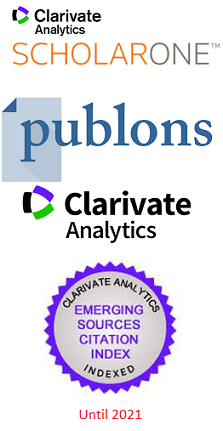The The Aspects that Affect Verbal Communication in Intercultural Communications
DOI:
https://doi.org/10.7596/taksad.v12i1.3221Keywords:
Communication, Language, Verbal Communication, Intercultural CommunicationAbstract
Globally, people passed and raised in different environments, cultural backgrounds, situations, and circumstances. These several backgrounds can affect their communications in one way to another when they are transmitting, addressing, sending, sharing and receiving different perspectives, thoughts, guidance, advice or opinions from others. For that, the present study aims to discuss the aspects of verbal communication that facilitate and impede intercultural communication between human beings. The aspects that the study is discussing are related to speaking skills and writing skills including voice, the diction of words, and phraseology. This article uses critical analysis and fact data from both society and the written documents of scholars, for giving and addressing clear outcomes. The study advises that people should be aware of their counterparts' cultural backgrounds in order to facilitate their communications effectively. It also advises the communicators to make some research about the culture of their counterparts and train themselves about other’s languages and their usage.
References
Alshami, I. (2019). Language and linguistics. Retrieved from: https://www.researchgate.net/publication/331454003_Language_and_linguistics
Auwalu, I. A. et al. (2015). The Meaning and Theory of Intercultural Communication. https://www.researchgate.net/publication/309155695_The_Meaning_and_Theories_of_Intercultural_Communication
Awoniyi, T. A. (1982). The Teaching of African Languages. London: Hodder and Stoughton
BBC (2021). The main Aspects of a performance. Retrieved from: https://www.bbc.co.uk/bitesize/guides/zqtgq6f/revision/2#:~:text=Pitch%20%E2%80%93%20speaking%20in%20a%20high,of%20response%20in%20an%20argument.&text=Intonation%20%E2%80%93%20the%20rise%20and%20fall,to%20say%20what%20we%20mean.
Fatimayin, F. F. (2018). What is Communication? Retrieved from: https://www.researchgate.net/publication/337649561_What_is_Communication
Hall, E.T. (1959). The silent language. New York: Anchor Books
Hero course (2021). Effective Communications. Retrieved from: https://courses.lumenlearning.com/boundless-communications/chapter/effective-vocal-delivery/#:~:text=Volume%20is%20the%20perceived%20loudness,and%20adjust%20sound%20production%20accordingly.
Jens, A. (1985) “Intercultural Communication”, English Translation of Tvarkulturell Kommunikation. Retrieved from: https://www.academia.edu/3956907/Intercultural_communication
Szkola, W. (2021). Verbal Communication. Retrieved from: https://www.wsbinoz.edu.pl/wgrane-pliki/kaffi_verbal-communication.pdf
Knoelton, E. G. & Lartin T. K. (2006). The Influence of Voice Volume, Pitch, and Speech Rate on Progressive Relaxation Training: Application of Methods from Speech Pathology and Auditory. Retrieved from: https://www.researchgate.net/publication/6847959_The_Influence_of_Voice_Volume_Pitch_and_Speech_Rate_on_Progressive_Relaxation_Training_Application_of_Methods_from_Speech_Pathology_and_Audiology
Lumen Candera (2021). Waves and Wavelengths. Retrieved from: https://courses.lumenlearning.com/suny-fmcc-intropsychmaster/chapter/waves-and-wavelengths/
Merriam-Webstar (2021). English Dictionary (Online). Retrieved from: https://www.merriam-webster.com/
Michigan ELT (2009). Bridging the cross-cultural gap. Retrieved from: https://www.press.umich.edu/pdf/9780472033577-ch1.pdf
Mwakapina, J. W. (2021). What is the Nature of Language? How does it Behave? What is Language Learning then? A Review Paper in Applied Linguistics. https://www.researchgate.net/publication/357403580_What_is_the_Nature_of_Language_How_does_it_Behave_What_is_Language_Learning_then_A_Review_Paper_in_Applied_Linguistics
Oxford (2021) English Dictionary (Online). Retrieved from: https://www.oxfordlearnersdictionaries.com/
Alembong, N. (2014). The Passing Wind. Cameroon. Available on: https://postcolonialinterventions.files.wordpress.com/2019/02/4.1zuhmboshi.pdf
Sage Edge (2021). Verbal Communication. Chapter four. Sage Publications. Retrieved from: https://www.sagepub.com/sites/default/files/upm-binaries/59343_Chapter_4.pdf
Sardi, A., Atmowardoyo, H., and Weda, S. (2017). The Distinct Types of Diction Used by the EFL Teachers in the Classroom Interaction. Retrieved from: https://www.researchgate.net/publication/319065722_The_Distinct_Types_of_Diction_Used_by_the_EFL_Teachers_in_the_Classroom_Interaction
The Acrolinx Team (2015). What Is Tone of Voice and Why Does It Matter? (Updated in 2021). Retrieved from: https://www.acrolinx.com/blog/what-is-tone-of-voice/#:~:text=The%20Acrolinx%20Team,who%20reads%20or%20hears%20you.
Downloads
Published
How to Cite
Issue
Section
License
Copyright (c) 2023 Journal of History Culture and Art Research

This work is licensed under a Creative Commons Attribution 4.0 International License.
All papers licensed under Creative Commons 4.0 CC-BY.- Share — copy and redistribute the material in any medium or format
- Adapt — remix, transform, and build upon the material for any purpose, even commercially.
Under the following terms:
Attribution — You must give appropriate credit, provide a link to the license, and indicate if changes were made. You may do so in any reasonable manner, but not in any way that suggests the licensor endorses you or your use.
- No additional restrictions — You may not apply legal terms or technological measures that legally restrict others from doing anything the license permits.






